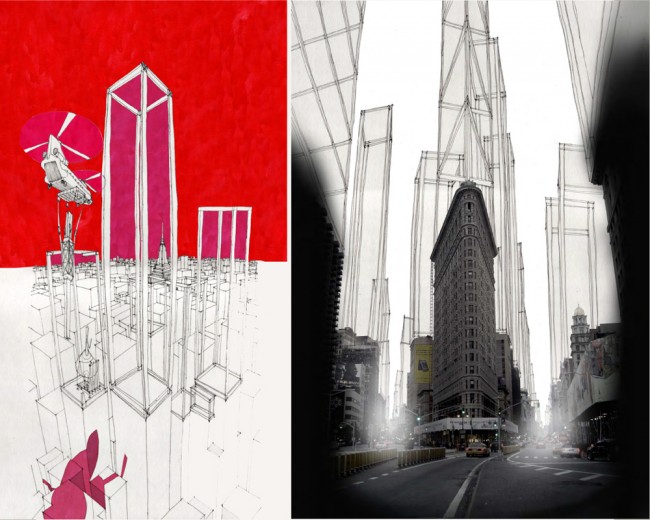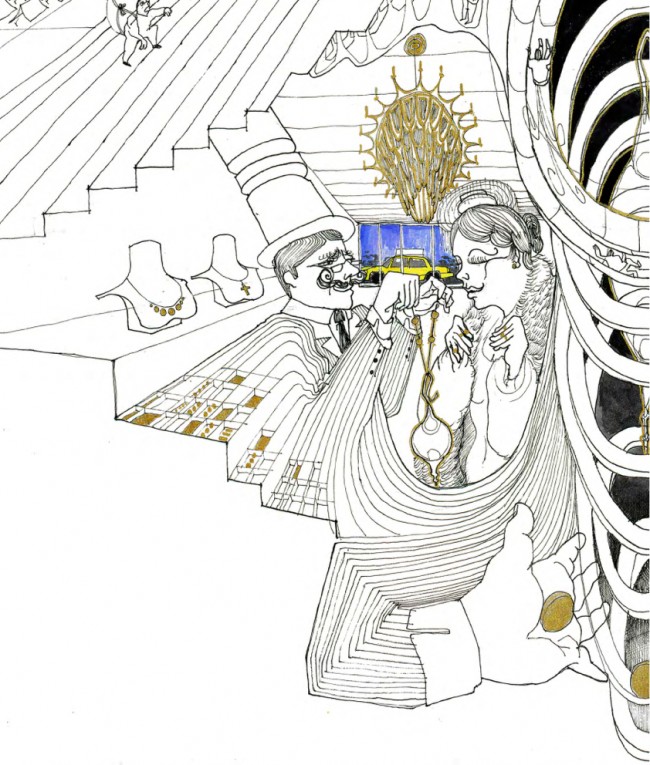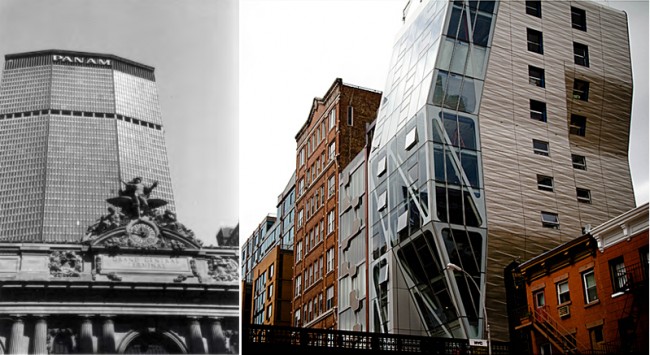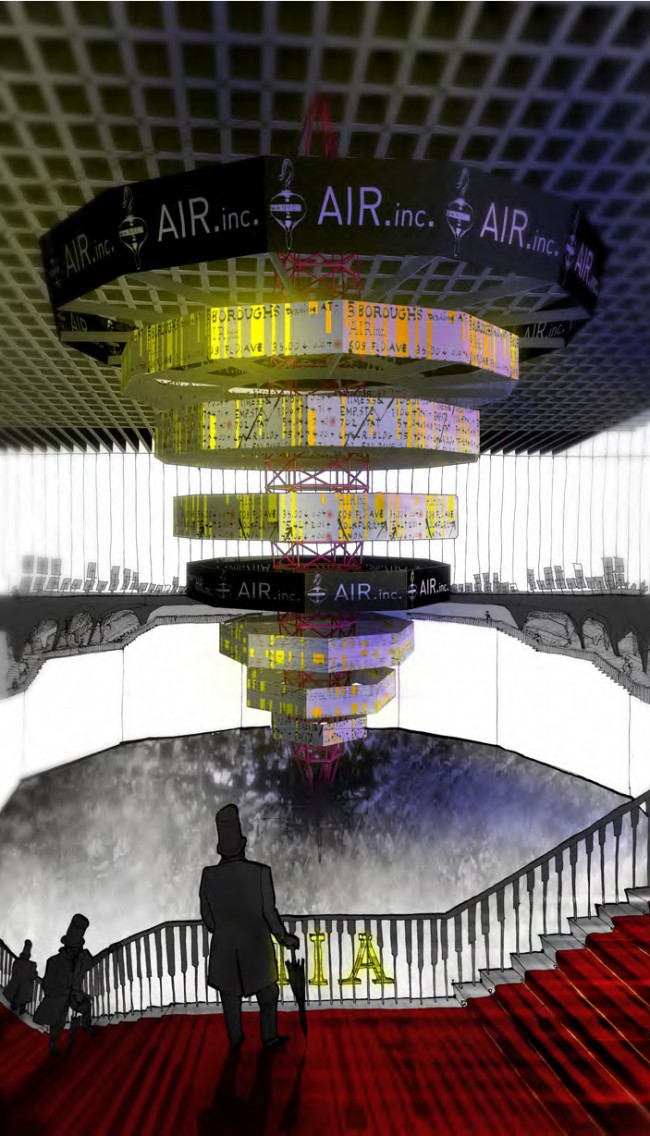
We are celebrating 15 years — and counting — of stories that are deeply researched and deeply felt, that build a historical record of what the city has been.
We are celebrating 15 years — and counting — of stories that are deeply researched and deeply felt, that build a historical record of what the city has been.
“Cuius est solum, eius est usque ad coelum et ad inferos”
Whoever owns [the] soil, [it] is theirs all the way [up] to Heaven and [down] to Hell.
–Accursius, circa 13th century C.E.

In the Air Futures system, property owners make tangible their claims to the volumes of space above their buildings as symbols of ownership, control, and wealth.
Transferable Development Rights (TDR) or “air rights” are real estate development tools that turn the municipal land use controls that restrict the height and bulk of buildings into an opportunity to buy and sell finite units of undeveloped air. Therefore, TDR provides local governments with an effective and flexible tool to ensure that the municipality can achieve the right mix of building density and open space without causing a financial burden to individual landowners or constricting desired development. When used well, TDR programs can bring cost-effectiveness and efficiency to real estate development projects, particularly near historic properties (like Grand Central Terminal or the High Line) whose preservation means ceding (or selling) their right to build to the maximum floor-to-area ratio (FAR) permitted for their site. In this week’s feature, Theo Games Petrohilos shares a darkly comic vision of an imagined future in which the responsible use of this effective tool for development has given way to a mass hysteria about air as an investment, divorced from proximity or association to any specific site. In such a scenario, the air we breathe becomes both a commodity – like gold or oil – and the basis for an abstract financial instrument disconnected from any physical properties — like the collateralized debt obligations (CDOs) or derivatives that have wreaked havoc on our economy in recent years.
For his Master’s thesis at the Bartlett School of Architecture at University College London, Petrohilos devised a complex architectural proposal for a building central to the financial operations of this dystopian future, the downtown headquarters of the Air Futures Company, a bank that would broker agreements to buy or sell development rights – in other words, air – in an open investment market (check out more of his renderings and models here). In addition to a series of striking illustrations that allude to the fat cats of the board game Monopoly and the expressionistic menace of Edvard Munch and Egon Schiele, Petrohilos’ research touches on New York’s particular history – and potential future – with the financialization of real estate, the reality of fictitious capital, and the specter of economic hysteria. What follows is a a brief summary of what he has uncovered and a selection of the evocative images he has created.
-C.S.
The system of Transferable Development Rights (TDR) or “air rights” – which allows property owners to sell their right to build in the air above their properties to the owners of nearby properties – has been making an impact on the built environment of New York City since the 1960s. As the use of this system increases, it’s not hard to imagine a shift from the use of air rights as a development tool and towards their use as an investment tool, detached from real-world properties. Gold, for example, is a commodity that historically served as a basis of value for the paper IOUs we call cash. Cash, in turn, disembodies value from the physical properties and presence of the commodity. Gold also creates an aura of worth and beauty as it glistens in the light or adorns a woman’s neck. Could air become similarly valuable? Becoming a treasured part of people’s lives that, bit by bit, develops a market that other financial instruments will rely on?

The Air Boutique sells to the discerning buyer a selection of some of the finest and most expensive vials of air.
As a development tool and an object of trade, TDR is currently used in a variety of ways. Property owners purchase certain air rights to increase their FAR (floor-to-area ratio) on a given plot within the city, transferring rights from a plot elsewhere that does not fully utilize its own FAR to benefit their plot. In areas where density is regulated, the system is used to compensate owners for the potential loss of revenue due to the regulation of height. Another use is as a method to halt development, or to exert an influence over the specifics of a project. Sometimes air rights are bought and hoarded as a tactic to increase their value. There are many other ways that this system manifests itself, but the fundamental idea is the trade of air based on a speculative concept of its worth. As in any market, investors have an interest in increasing the value of this new commodified air, which can lead to speculation and the inflated value of these tradeable claims to paper wealth. As the use and commodification of this tool intensifies, questions remain about how the trade will affect the built environment (and the real estate finance) of New York City.
Government officials and speculators alike are actually looking into the creation of an Air Bank, where air rights can be accumulated and divided just like shares. Air rights would also be able to be transferred from one district to another, so the playing field, and the potential profits, would be much larger. Brokers and traders would be brought in to facilitate these movements for new investors, who are betting on the potential of these air stocks to perform for them. Plans for a TDR trading system that performs like a bank – basing credit extension and perceptions of wealth upon the speculative value of these stocks – further distances ideas of value from the actualities of the physical commodity, the air above a building.

Left: The height of the Pan Am (now MetLife) building is a result of Grand Central Terminal selling its development rights | Right: The shape of Neil Denari’s HL23 benefited from a similar air rights deal with the High Line. Image via Curbed.
The first real air rights building, constructed notionally over Grand Central Terminal in New York, was the Pan Am Building by Walter Gropius, Emery Roth & Sons, and Pietro Belluschi (built from 1958-62). It saw the cash-strapped owners of the railway terminal sell the right to develop the unused air above their building to the owners of the new building, thus symbolically filling the void in zoning space above the station, even if slightly dislocated. As the largest office building in the world at that time, it straddled a part of Grand Central Station, thereby creating the first change in the development of new three-dimensional geodetic reference datums for New York City. The grid had always been a two-dimensional playground for solid extrusions of plots, but then a new horizon was opened up within the complexity of three-dimensional “air ownership.”
A contemporary example of changing datums is the celebrated High Line development. The transformation of the disused, industrial railway into elevated public parkland brought about the changing of the architecture that surrounds it. Neil Denari’s HL23 mini-condo tower, for example, purchased unused air rights from above the High Line in order to swell above its permitted size. The demand for height near this newly desirable area – one which otherwise has a relatively low zoning limit – has seen a large-scale selling of air rights to those who wish to rise above others. The perceived value of an air right is the future ability for someone to utilize it elsewhere, but the detachment from its physical reality or location highlights a potential future problem for the proposed air rights bank system. As this air becomes more of an investment tool than a realized development, it becomes another commodity that can be manipulated and exploited in the financial markets. As a financial instrument, it would be subject to the same excitable fluctuations as any share price on any trading floor.

The heart of the Air Futures system is a flashing ticker that broadcasts values to the trading floor below.
Currently, the air rights trade in New York is limited to transactions that are site-specific and relatively small, with values closely associated with both the donor and receiver sites. Therefore, as a development tool, the system appears to be manageable and efficient. As an investment tool, however, air would become subject to the same thinking that got us into our current financial mess: totally detached from reality and fully entering the maniacal world of speculation. If air itself – as opposed to a site-specific right to develop property in a specific, regulated way – becomes a commodity, new institutions that deal in its trade will have to be developed. To explore this idea, I developed an architectural proposal for an imagined future in which the trade of air is commonplace, an architecture that deals with the commodification of an indefinable and ubiquitous product. While the thinking behind this project is prospective, it references precedents in certain “mania commodities” of the past. My design scheme for the headquarters of the Air Futures Company reflects the maniacal nature of this hypothetical trade.
We saw a similar scenario play out with John Law’s Mississippi Scheme and his new Bank Generale (later renamed the Bank Royale) in the early 1700s. The fortunes of the French nation were tied up in the new paper currency Law produced, which was underwritten by promises of the continual exploitation of land and natural resources in America. The values of stock became so overinflated that people forgot where the actual value was coming from. When the value of this magical growth was questioned in 1720, the system collapsed catastrophically, bringing the nation to its knees. The Mississippi Scheme bubble was not the first, and certainly not the last, example of misguided faith in and frenzy surrounding speculative ventures. The famous case of Holland’s “Tulipomania” likewise lasted for a short but intense period in 1636-37, and saw people lose their houses and life savings for having invested in the humble tulip bulb. The hysterical grab for what in its unrealized state looks like no more than an onion bloomed at an exponential rate for less than a year, and then crashed in merely a day. A failure in crops of the precious commodity meant that much of the money invested in their promised delivery was lost. Further examples of failed speculative ventures in recent history are more abundant than tulips; names like Ponzi or Madoff, or even Lehman Brothers, call into question our faith in financial instruments. History repeats itself, and when the commodity is forgotten – left to disappear into the ether, like air – all you are left with is speculation on speculation.
The commodity itself is not the problem; the problem arises when the system becomes subject to the greed and whimsy of excited people. Any value of the air commodity is based on the speculative ideas of how it could be used to develop in the future. The intangibility of this future makes it subject to both the coercement of traders and the maniacal strutting of crowds eager to get on the wagon.
With everything else in the world commodified, what else is there left? The air that we breathe, the air we trade, is the new commodity in a city like New York. History teaches us that the consequences of mania creation are erratic and often devastating. All that is staked on air is staked on abilities to perpetuate this mania. Marx saw the fetishizing of commodities as exerting a far-reaching power over mankind, and his stories of course ended with revolutions. We must be careful not to upset the balance… but creating gold from air? Now that sounds like a plan…
Our last breath may be our deepest.
Unless otherwise noted, all images by Theo Games Petrohilos. All rights reserved.
Theo Games Petrohilos is an architect and designer and recent graduate of the Bartlett School of Architecture, University College London. He has worked with Make Architects, Alsop Architects, and David Chipperfield Architects. He lives in London. You can view more of his work at his personal website.
The views expressed here are those of the author only and do not reflect the position of Urban Omnibus editorial staff or the Architectural League of New York.
The views expressed here are those of the authors only and do not reflect the position of The Architectural League of New York.
Comments